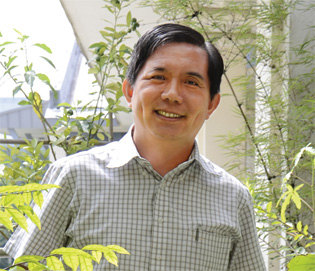Why Singapore’s English Teachers Should Embrace Singlish, Not Fight It
Is it time for Singaporean educators to embrace Singlish as a legitimate learning tool? What the Research […]
Read More
What does a Mother Tongue Language teacher need to know in order to teach well? According to Professor Goh Yeng Seng, it is not enough to master the language you teach, especially when most students today come from English-speaking homes.
“If you ask me, between being a teacher and an Academic Group Head, which do I prefer? Of course, teaching!”
Without a doubt, Professor Goh Yeng Seng enjoys teaching. His eyes light up when he recounts his teaching days in schools and at NIE. He taught Chinese Language and Literature in secondary schools and at the junior college level from 1986 to 1992.
These days, however, he’s busy leading the Asian Languages and Cultures Academic Group in NIE, a role he assumed in 2006. The AG comprises three divisions – Chinese, Malay and Tamil Languages – and oversees the training of Mother Tongue Language (MTL) teachers.
A prominent scholar in bilingualism, Prof Goh’s research interest stems from his own experience as a Chinese teacher. He remembers vividly, as a trainee teacher, facing a class where the majority of students came from English-speaking homes.
 “I faced a big challenge: How to teach them? When I speak Chinese, they can’t understand me. But at that time, we can only use the monolingual-direct approach, namely, Chinese only.” Speaking English in a Chinese classroom was prohibited.
“I faced a big challenge: How to teach them? When I speak Chinese, they can’t understand me. But at that time, we can only use the monolingual-direct approach, namely, Chinese only.” Speaking English in a Chinese classroom was prohibited.
The situation has become more critical now because of the rapidly changing language backgrounds of students in Singapore. MOE surveys show that in 2010, 61% of Primary 1 Chinese pupils speak English at home, while only 39% speak Mandarin.
This poses a big problem for Chinese Language teachers because many of their pupils have no foundation in spoken Mandarin. “Even if they do know basic Chinese, it’s not enough to cope with the school curriculum,” he says.
The challenge is even more acute for Tamil Language teachers, because an even higher proportion of Tamil families no longer use the language at home.
In 2001, Prof Goh had an opportunity to make a unique contribution when he began researching an approach where both teachers and pupils are allowed to use Chinese and English in selective contexts in the CL2 (Chinese as a 2nd language) classroom, particularly at the early stage of learning.
This bilingual approach has received positive feedback from pupils, teachers and parents. “My research in CL2 can be applied to Malay and Tamil. These three mother tongues face the same problems.”
Prof Goh’s bilingual approach to MTL teaching was inspired by an observation he made while studying in Taiwan – all the Taiwanese linguistics professors who did their PhD study in US universities were bilingual. This gave him new impetus to master his second language.
He has the same vision for our MTL teachers. He wants them to not only be proficient in their MT language, but also become effectively bilingual. “If you want to teach L2, you must be bilingual.”
He makes a distinction between acquiring a first language (L1) and learning a second language (L2). “L1 and L2 teaching are totally different,” he explains. “The teacher must be bilingual and know how to make full use of English as a resource,” rather than to see it as “taboo” in the MTL classroom.
“Teacher training also becomes different. Our new challenge is that training bilingual teachers is truly new territory,” he adds. “We train teachers with bilingual tools- -even if you’re bilingual, it doesn’t mean you know how to use bilingual resources to teach.”
To be a good MTL teacher, a strong foundation in the MT language is a given, says Prof Goh. He lists the must-knows for language teachers: general linguistics, phonology, orthography, vocabulary, syntax, and development of L2 skills in listening, speaking, reading and writing.
To this list, he adds a new skill: translation. “Learning MTL as a second language can help in translation. Students are asked questions in Chinese and they reply in English.”
– Prof Goh Yeng Seng, Asian Languages and Cultures Academic Group
“This bilingual approach to MTL teaching – including learning the skill of translation – helps to equip our students with the language ability to navigate the increasingly globalized world, between the East and the West.”
With the emphasis on 21st century skills, teachers also need to think critically in order to mould today’s students into critical and independent thinkers. “When I teach students in my class, I wouldn’t give them standard answers. I’ll ask them many, many questions again and again.”
“My students always say: Why do you have so many ‘whys’? After I’ve finished answering your why, you go and ask me why again!” he recalls with a laugh. “Well, I tell them: It’s because you didn’t think about the topic deeply enough.”
Enjoyment evidently plays a very big part in his teaching. “My students always say: You look like you enjoy the class more than us. But of course, if I don’t enjoy my class, how can I inspire them? How can they enjoy my lesson?”
“Through these interactions with them, I can learn a lot too. I want to make the lessons challenging for them, rather than use a prescriptive form of teaching. And you will enjoy it too, as a teacher.”
When asked what advice he would give to new and aspiring language teachers, Prof Goh has this to offer: “I always say you must be proud of your profession. Enjoy it! Enjoy your lessons! Enjoy your profession! Be proud of that!”